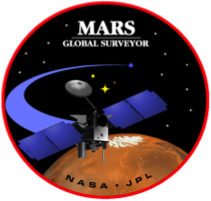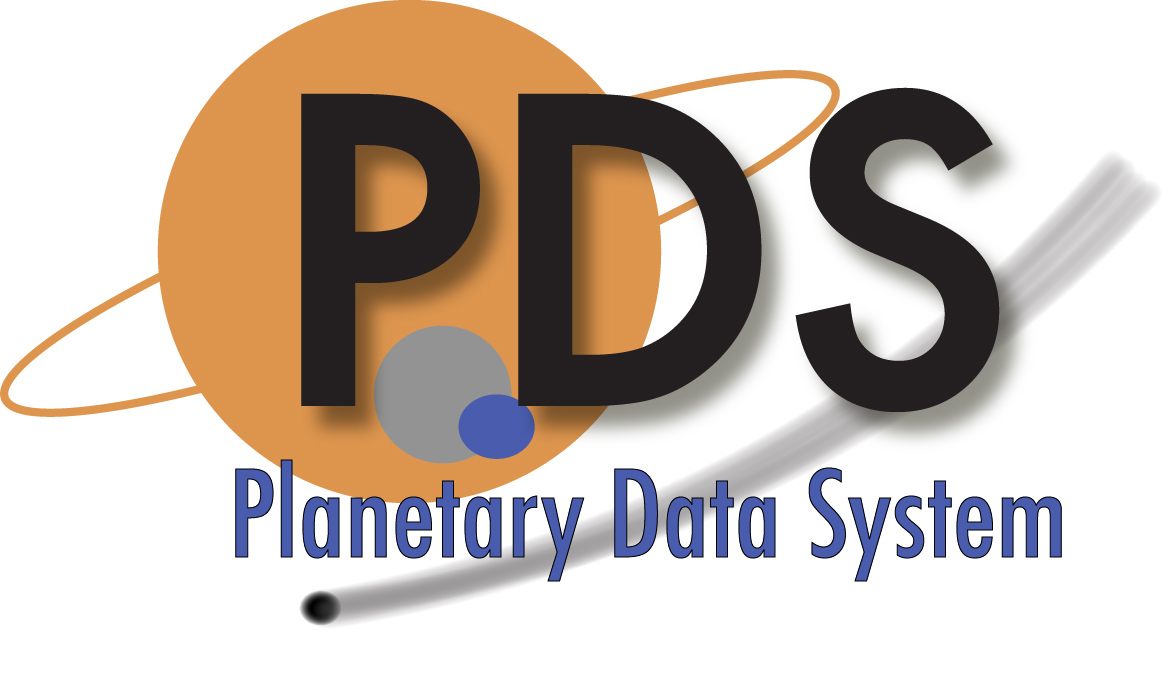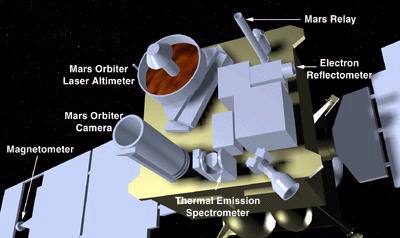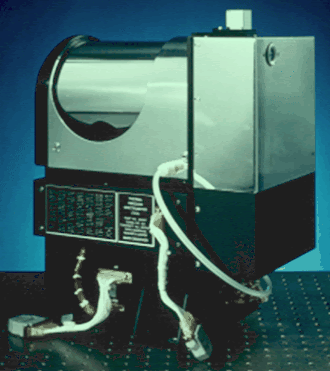
The Thermal Emission Spectrometer (TES)
Description of the Instrument
The TES instrument uses a Michelson interferometer (covering the thermal IR with a wavelength range from 6 to 50 microns (~1650-200 cm-1) with 5 and 10 cm-1 spectral sampling (~10 and 20 cm-1 resolution) to make infrared spectrometric measurements. Two sets of broad-band bolometric detectors cover the thermal (5.5 to 100 microns) and visible (0.3 to 2.7 micron) bolometric bands. Each sensor has six detectors arranged in a 3 X 2 array, each with a field-of-view of 8.3-mrad, translating to a spatial resolution of 3 km from the MGS orbit. In addition, the instrument has a rotating pointing mirror that allows it to take measurements from the nadir position up to and past the limb in both the fore and aft directions. Additionally, the pointing mirror can be positioned to take measurements of space, and of the internal reference surfaces and lamps contained within the body of the TES instrument. The TES onboard Data Editor aggregates the spectral data from the six detectors, in order to reduce the total amount of data to be downlinked (see specmask.pdf).
Reference
Christensen, P.R., Bandfield, et al. 2001. Mars Global Surveyor Thermal Emission Spectrometer experiment: investigation description and surface science results. JGR: Planets, 106(E10), pp.23823-23871.
Description of data
This dataset contains calibrated thermal IR radiance spectra and atmospheric and surface properties derived from this data. Also included are the parameters that describe the calibration functions for subsets of data. All TES spectrometer data (raw spectra) from original PDS data volumes were processed. The TES spectra in this archive were re-calibrated using a new calibration algorithm that removes radiance artifacts from the TES calibration functions and the observed spectra, and also accounts for the temperature dependence of the instrument response function (IRF). The details on the new re-calibration algorithm can be found in the User’s Guide document.
The original TES data were produced by the TES science Team at Arizona State University and archived by the Geosciences Node. These data are in ASCII tables with detached XML labels. The six detectors are listed in sequence with time given in terms of the spacecraft clock (SCLK), which is defined as seconds since 12:00a.m. January 1, 1980.
This recalibration effort strives to improve the accuracy of the TES calibration by accounting for the Instrument Response Function dependence on instrument temperature throughout the MGS TES mission. This recalibration applies only to the data collected by TES spectrometer and excludes the data collected by visible and thermal bolometers.
The recalibration products consist of several datasets. The following indices list the various datasets (See the user’s guide)
Indices of the Individual Datasets
The following indices list the files giving URN, Start and Stop Time, Ls and Martian year.
Thermal Emission Spectrometer Data Recalibration Users’ Guide
Calibrated data (CSV)
Derived Data
Surface emissivity and associated surface products
Accessing the Data
Downloading the data
MGS TES atmos-opacity
MGS TES surf-emissivity MGS TES recalib
Citing the Datasets for Publications
Pankine, A., (2022), Mars Global Surveyor Thermal Emission Spectrometer Atmospheric Recalibration Bundle, NASA Planetary Data System, https://doi.org/10.17189/xhqz-zw13.
The TES instrument uses a Michelson interferometer (covering the thermal IR with a wavelength range from 6 to 50 microns (~1650-200 cm-1) with 5 and 10 cm-1 spectral sampling (~10 and 20 cm-1 resolution) to make infrared spectrometric measurements. Two sets of broad-band bolometric detectors cover the thermal (5.5 to 100 microns) and visible (0.3 to 2.7 micron) bolometric bands. Each sensor has six detectors arranged in a 3 X 2 array, each with a field-of-view of 8.3-mrad, translating to a spatial resolution of 3 km from the MGS orbit. In addition, the instrument has a rotating pointing mirror that allows it to take measurements from the nadir position up to and past the limb in both the fore and aft directions. Additionally, the pointing mirror can be positioned to take measurements of space, and of the internal reference surfaces and lamps contained within the body of the TES instrument. The TES onboard Data Editor aggregates the spectral data from the six detectors, in order to reduce the total amount of data to be downlinked (see specmask.pdf).
Reference
Christensen, P.R., Bandfield, et al. 2001. Mars Global Surveyor Thermal Emission Spectrometer experiment: investigation description and surface science results. JGR: Planets, 106(E10), pp.23823-23871.
Description of data
This dataset contains calibrated thermal IR radiance spectra and atmospheric and surface properties derived from this data. Also included are the parameters that describe the calibration functions for subsets of data. All TES spectrometer data (raw spectra) from original PDS data volumes were processed. The TES spectra in this archive were re-calibrated using a new calibration algorithm that removes radiance artifacts from the TES calibration functions and the observed spectra, and also accounts for the temperature dependence of the instrument response function (IRF). The details on the new re-calibration algorithm can be found in the User’s Guide document.
The original TES data were produced by the TES science Team at Arizona State University and archived by the Geosciences Node. These data are in ASCII tables with detached XML labels. The six detectors are listed in sequence with time given in terms of the spacecraft clock (SCLK), which is defined as seconds since 12:00a.m. January 1, 1980.
This recalibration effort strives to improve the accuracy of the TES calibration by accounting for the Instrument Response Function dependence on instrument temperature throughout the MGS TES mission. This recalibration applies only to the data collected by TES spectrometer and excludes the data collected by visible and thermal bolometers.
The recalibration products consist of several datasets. The following indices list the various datasets (See the user’s guide)
Indices of the Individual Datasets
Coefficients of IRF fit for spectral channel 6-143 single scans of 6 detectors (CSV) 2.8 Mb
Coefficients of IRF fit for spectral channel 11-286 double scans of 6 detectors (CSV) 3.0 Mb
Instrument Effective Emissivity for 6 detectors for channels 6-143 (CSV) 1.1 MB
Instrument Effective Emissivity for 6 detectors for channels 11-286 (CSV) 1.1 Mb
Instrument Temperature for 6 detectors single scans (CSV) 89.0 Mb
Instrument Temperature for 6 detectors double scans (CSV) 22.4 Mb
Coefficients of IRF fit for spectral channel 11-286 double scans of 6 detectors (CSV) 3.0 Mb
Instrument Effective Emissivity for 6 detectors for channels 6-143 (CSV) 1.1 MB
Instrument Effective Emissivity for 6 detectors for channels 11-286 (CSV) 1.1 Mb
Instrument Temperature for 6 detectors single scans (CSV) 89.0 Mb
Instrument Temperature for 6 detectors double scans (CSV) 22.4 Mb
The following indices list the files giving URN, Start and Stop Time, Ls and Martian year.
Calibrated Spectral Radiance Channels 6-143 single scan (CSV) 299,177 Mb
Calibrated Spectral Radiance Channels 11-286 double scan (CSV) 136,317 Mb
Calibrated Spectral Radiance Channels 11-286 double scan (CSV) 136,317 Mb
Thermal Emission Spectrometer Data Recalibration Users’ Guide
Calibrated data (CSV)
Derived Data
Nadir aerosols opacities and surface temperatures
The re-calibrated radiances and a better understanding of the TES radiometric error were used to retrieve opacities of the atmospheric aerosols and surface temperatures from MGS TES nadir spectra (see the User’s Guide, page 18, 4.3)
Index of data set (CSV)
The re-calibrated radiances and a better understanding of the TES radiometric error were used to retrieve opacities of the atmospheric aerosols and surface temperatures from MGS TES nadir spectra (see the User’s Guide, page 18, 4.3)
Index of data set (CSV)
Surface emissivity and associated surface products
This recalibration includes new surface emissivity products that span the entire MGS mapping mission as well as several ancillary model parameters that are of use for surface and atmospheric studies. (see the User’s Guide, page 18, 4.4)
Index of data set (CSV)
Index of data set (CSV)
Accessing the Data
Downloading the data
MGS TES atmos-opacity
MGS TES surf-emissivity MGS TES recalib
Citing the Datasets for Publications
Pankine, A., (2022), Mars Global Surveyor Thermal Emission Spectrometer Atmospheric Recalibration Bundle, NASA Planetary Data System, https://doi.org/10.17189/xhqz-zw13.
 PDS: The Planetary Atmospheres Node
PDS: The Planetary Atmospheres Node



